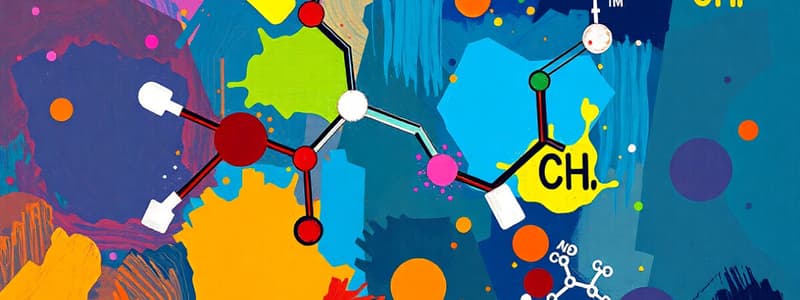Podcast
Questions and Answers
Which of the following correctly defines Huckel's rule?
Which of the following correctly defines Huckel's rule?
- An aromatic compound must have 4n + 2 π electrons. (correct)
- An aromatic compound can have any number of π electrons.
- A compound's aromaticity is determined by its molecular weight.
- A non-aromatic compound must have 2n π electrons.
What is the primary purpose of saponification in organic chemistry?
What is the primary purpose of saponification in organic chemistry?
- To neutralize acids in an organic reaction.
- To esterify fatty acids.
- To convert glycerides into alcohols.
- To hydrolyze fats and oils into glycerol and fatty acids. (correct)
Which statement about the rancidity of oils is accurate?
Which statement about the rancidity of oils is accurate?
- Rancidity has no impact on the flavor of oils.
- Rancidity occurs only in solid fats.
- Rancidity is an oxidation process that can be prevented through refrigeration. (correct)
- Rancidity is caused solely by microbial activity.
What structural feature is common to an aromatic compound such as anthracene?
What structural feature is common to an aromatic compound such as anthracene?
Which is a characteristic reaction of benzoic acid?
Which is a characteristic reaction of benzoic acid?
In the preparation of 1-naphthol from naphthalene, which reagent is primarily used?
In the preparation of 1-naphthol from naphthalene, which reagent is primarily used?
Acid and iodine values are both measures of what property in organic compounds?
Acid and iodine values are both measures of what property in organic compounds?
What is the major difference between fats and oils in terms of their chemical structure?
What is the major difference between fats and oils in terms of their chemical structure?
Flashcards
Resonance in Benzene
Resonance in Benzene
Benzene's stability due to electron delocalization, creating a resonance structure where electrons are shared equally.
Saponification Value
Saponification Value
The amount of KOH needed to saponify a fat (convert it to soap).
Rancidity of Oils
Rancidity of Oils
The spoilage of oil due to oxidation caused by oxygen in the air.
Electrophilic Substitution Reactions in Benzene
Electrophilic Substitution Reactions in Benzene
Signup and view all the flashcards
Huckel's Rule
Huckel's Rule
Signup and view all the flashcards
Ester Value
Ester Value
Signup and view all the flashcards
Diazotization
Diazotization
Signup and view all the flashcards
Benzene to Anthracene
Benzene to Anthracene
Signup and view all the flashcards
Study Notes
Pharmaceutical Organic Chemistry II Exam - January 2020
- Instructions: Students must not write anything other than their roll number on the exam paper. Any other writing constitutes cheating.
- Exam Structure: The exam contains three sections (A, B, and C) and is divided into multiple question types.
- Section A: Contains 10 very short answer questions (5 marks each). All questions in this section must be answered.
- Section B: Contains 3 descriptive questions (10 marks each), students must choose 2 to answer.
- Section C: Contains 7 short answer questions (5 marks each). Students must answer four or three of these (depending on the question numbering in the exam paper).
Section A - Very Short Answer Questions
- Example topics/questions:
- Resonance in Benzene
- Saponification value
- Rancidity of oils
- Saccharin's structure and use
- Ester value
- DDT's structure and uses
- Huckel's rule
- Anthracene structure and uses
- Triphenylmethane structure and uses
- Reichert-Meissl value
Section B - Long Answer Questions
- Topics/questions:
- Mechanisms of electrophilic substitution reactions in benzene (e.g., sulfonation, halogenation).
- Properties of fats and oils and their differences from waxes. Chemical reaction examples.
- Synthesis of compounds from naphthalene (e.g., 1-Fluoronaphthalene, 1-Naphthol, 1-Cyclonaphthalene, 1-Chloro-2-naphthylamine, 1-Iodonaphthalene).
Section C - Short Answer Questions
- Topics/questions:
- Converting benzene to anthracene
- Phenol, cresol, and resorcinol structures and uses
- Basicity of amines
- Diazotization and synthetic uses of diazonium salts
- Chemical reactions of benzoic acid
- Acid and iodine value
- Baeyer's strain theory and limitations
- Structures and uses of BHC, chloramine, and diphenylmethane
- Sachse-Mohr theory
Studying That Suits You
Use AI to generate personalized quizzes and flashcards to suit your learning preferences.




